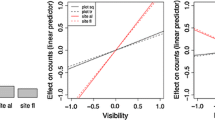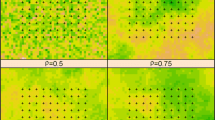Abstract
Population density, one of the most fundamental demographic attributes, may vary systematically with spatial scale, but this scale-sensitivity is incompletely understood. We used a novel approach—based on fully censused and mapped distributions of eastern grey squirrel (Sciurus carolinensis) dreys, beaver (Castor canadensis) lodges, and moose (Alces alces)—to explore the scale-dependence of population density and its relationship to landscape features. We identified population units at several scales, both objectively, using cluster analysis, and arbitrarily, using artificial bounds centred on high-abundance sites. Densities declined with census area. For dreys, this relationship was stronger in objective versus arbitrary population units. Drey density was inconsistently related to patch area, a relationship that was positive for all patches but negative when non-occupied patches were excluded. Drey density was negatively related to the proportion of green-space and positively related to the density of buildings or roads, relationships that were accentuated at coarser scales. Mean drey densities were more sensitive to scale when calculated as organism-weighted versus area-weighted averages. Greater understanding of these scaling effects is required to facilitate comparisons of population density across studies.



Similar content being viewed by others
References
Amarasekare P (1994) Spatial population structure in the banner-tailed kangaroo rat, Dipodomys spectabilis. Oecologia 100:166–176
Bergerud AT, Manuel F (1969) Aerial census of moose in central Newfoundland. J Wild Manage 33:910–916
Bethke R, Taylor M, Amstrup S, Messier F (1996) Population delineation of polar bears using satellite collar data. Ecol Appl 6:311–317
Bowers MA, Matter SF (1997) Landscape ecology of mammals: relationships between density and patch size. J Mammal 78:999–1013
Clutton-Brock TH, Major M, Guinness FE (1985) Population regulation in male and female red deer. J Anim Ecol 54:831–846
Coles JM, Orme BJ (1983) Homo sapiens or Castor fiber? Antiquity 57:95–102
Connor EF, Courtney AC, Yoder JM (2000) Individuals-area relationships: the relationship between animal population density and area. Ecology 81:734–748
Don BAC (1985) The use of drey counts to estimate grey squirrel populations. J Zool 206:282–286
Gaston KJ, Matter SF (2002) Individuals-area relationships: comment. Ecology 83:288–293
Gaston KJ, Blackburn TM, Gregory RD (1999) Does variation in census area confound density comparisons? J Appl Ecol 36:191–204
Hobbs NT (2003) Challenges and opportunities in integrating ecological knowledge across scales. For Ecol Manage 181:223–238
Kareiva P (1983) Influence of vegetation texture on herbivore populations: resource concentration and herbivore movement. In: Denno RF, McClure MS (eds) Variable plants and herbivores in natural and managed systems. Academic, New York, pp 259–289
Kenkel NC (1986) Structure and dynamics of jack pine stands near Elk Lake, Ontario: a multivariate approach. Can J Bot 64:486–497
Kotlier NB, Wiens JA (1990) Multiple scales of patchiness and patch structure: a hierarchical framework for the study of heterogeneity. Oikos 59:253–260
Lewontin RC, Levins R (1989) On the characterization of density and resource availability. Am Nat 134:513–524
Lloyd M (1967) Mean crowding. J Anim Ecol 36:1–30
MacArthur RH, Wilson EO (1967) The theory of island biogeography. Princeton University Press, Princeton
MacArthur RH, Diamond JM, Karr JR (1972) Density compensation in island faunas. Ecology 53:330–342
Manning AD, Lindenmayer DB, Nix HA (2004) Continua and Umvelt: novel perspectives on viewing landscapes. Oikos 104:621–628
Matter SF (1997) Population density and area: the role of between- and within-patch processes. Oecologia 110:533–538
Matter SF (2000) The importance of the relationship between population density and habitat area. Oikos 89:613–618
Mauritzen M, Derocher AE, Wiig O, Belikov SE, Boltunov AN, Hansen E, Garner GW (2002) Using satellite telemetry to define spatial structure in polar bears in the Norwegian and western Russian Arctic. J Appl Ecol 39:79–90
McIntyre S, Hobbs RJ (1999) A framework for conceptualizing human effects on landscapes and its relevance to management and research models. Conserv Biol 13:1282–1292
McLoughlin PD, Cluff HD, Gau RJ, Case RL, Messier F (2002) Population delineation of barren-ground grizzly bears in the central Canadian Arctic. Wildl Soc Bull 30:728–737
Morgan RA, Brown JS, Thorson JM (1997) The effect of spatial scale on the functional response of fox squirrels. Ecology 78:1087–1097
Purves DW, Law R (2002) Fine-scale spatial structure in a grassland community: quantifying the plant’s eye view. J Ecol 90:121–129
Ray C, Hastings A (1996) Density dependence: are we searching at the wrong spatial scale?. J Anim Ecol 65:556–566
Reed RA, Peet RK, Palmer MW, White PS (1993) Scale dependence of vegetation-environment correlations: a case study of a North Carolina piedmont woodland. J Veg Sci 4:329–340
Risch SJ (1981) Insect herbivore abundance in tropical monocultures and polycultures: an experimental test of two hypotheses. Ecology 62:1325–1340
Root RB (1973) Organization of a plant-arthropod association in simple and diverse habitats: the fauna of collards (Brassica oleraceae). Ecol Monogr 45:95–120
Schaefer JA, Mahoney SP (2003) Spatial and temporal scaling of population density and animal movement: a power law approach. Ecoscience 10:496–501
Schaefer JA, Messier F (1995) Scale-dependent correlations of arctic vegetation and snow cover. Arct Alp Res 27:38–43
Schoener TW (1986) Patterns in terrestrial vertebrate versus arthropod communities: do systematic differences in regularity exist? In: Diamond J, Case TJ (eds) Community ecology. Harper & Row, New York, pp 556–586
Simberloff DS, Wilson EO (1969) Experimental zoogeography of islands: the colonization of empty islands. Ecology 50:278–296
Smallwood KS, Schonewald C (1996) Scaling population density and spatial pattern for terrestrial, mammalian carnivores. Oecologia 105:329–335
Taylor MK, Akeeagok S, Andriashek D, Barbour W, Born EW, Calvert W, Cluff HD, Ferguson S, Laake J, Rosing-Asvid A, Stirling I, Messier F (2001) Delineating Canadian and Greenland polar bear (Ursus maritimus) populations by cluster analysis of movements. Can J Zool 79:690–709
Van Klink M (2003) Values and validity of stocking density in the Sami reindeer system: Assessment and comparison with the Fulani system. MSc Thesis, Wageningen University
Ward JH (1963) Hierarchical grouping to optimize an objective function. J Am Stat Assoc 58:236–244
Acknowledgements
This work was supported by the Natural Sciences and Engineering Research Council of Canada.
Author information
Authors and Affiliations
Corresponding author
Additional information
Communicated by John Fryxell
Rights and permissions
About this article
Cite this article
Mayor, S.J., Schaefer, J.A. The many faces of population density. Oecologia 145, 275–280 (2005). https://doi.org/10.1007/s00442-005-0114-4
Received:
Accepted:
Published:
Issue Date:
DOI: https://doi.org/10.1007/s00442-005-0114-4




